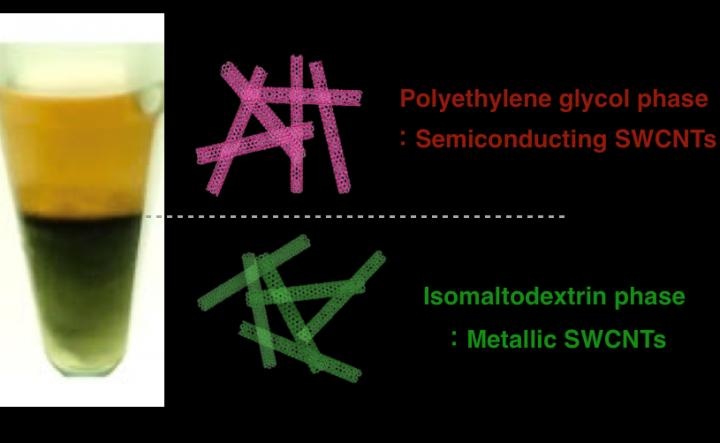Nov 5 2019
Researchers at Nagoya University in Japan have developed a novel and more cost-effective technique that allows easy and effective separation of two types of carbon nanotubes.
 The unwanted metallic SWCNTs deposited at the bottom of the solution, while the wanted semiconducting ones floated to the top. (Image credit: Haruka Omachi)
The unwanted metallic SWCNTs deposited at the bottom of the solution, while the wanted semiconducting ones floated to the top. (Image credit: Haruka Omachi)
The process can be up-scaled for synthesizing purified batches of single-wall carbon nanotubes (SWCNTs) that can be utilized in high-performance electronic devices. The study findings have been reported in the journal Applied Physics Express.
SWCNTs have remarkable mechanical and electronic properties, which make them perfect candidates for use in an extensive range of electronic devices, such as the thin-film transistors that are typically found in LCD displays. However, a major issue is that only two-thirds of the synthesized SWCNTs can be used in electronic devices.
Since the semiconducting SWCNTs are useful, they should be isolated from the unnecessary metallic ones. However, the most robust purification process, referred to as aqueous two-phase extraction, presently involves the use of an expensive polysaccharide, known as dextran.
Haruka Omachi, an organic chemist, and colleagues at Nagoya University theorized that the effectiveness of dextran in isolating semiconducting from metallic SWCNTs lies in the linkages joining its glucose units. The researchers did not use the dextran to isolate the two types of SWCNTs, but instead used the considerably cheaper isomaltodextrin, which contains several more of these linkages.
The researchers left a batch of SWCNTs in a solution containing polyethylene isomaltodextrin and glycol for 15 minutes, and subsequently centrifuged it for 5 minutes. Next, they tried three different types of isomaltodextrin, each with a different number of linkages and different molecular weight.
The team observed that while the metallic SWCNTs accumulated at the bottom isomaltodextrin portion of the solution, the semiconducting SWCNTs floated at the top polyethylene glycol portion.
The researchers found that the two types of SWCNTs were most effectively separated (99%) by the type of isomaltodextrin that had the most linkages and a high molecular weight. They also observed that another polysaccharide, known as pullulan and whose glucose units are linked with different kinds of linkages, was not effective in isolating the same types of SWCNTs.
According to the team, the type and number of linkages present in isomaltodextrin have a critical role to play in their ability to successfully isolate the SWCNTs.
In addition, the researchers discovered that a thin-film transistor constructed with their purified semiconducting SWCNTs performed extremely well.
Isomaltodextrin is a cost-effective and extensively available polysaccharide synthesized from starch that is utilized as a dietary fiber. This renders it a low-cost option for the SWCNT extraction process.
At present, Omachi and his collaborators are in discussions with companies to take their method to a commercial level. The team is also working to enhance the performance of thin-film transistors using semiconducting SWCNTs in sensor devices and flexible displays.
The article titled “Aqueous two-phase extraction of semiconducting single-wall carbon nanotubes with isomaltodextrin and thin-film transistor applications” has been published in Applied Physics Express.
The authors of the study include Haruka Omachi, Tomohiko Komuro, Kaisei Matsumoto, Minako Nakajima, Hikaru Watanabe, Jun Hirotani, Yutaka Ohno, and Hisanori Shinohara.